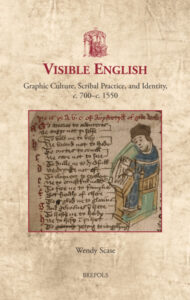Wendy Scase, Visible English: Graphic Culture, Scribal Practice, and Identity, c. 700-c. 1550 (Turnhout, 2022: USML 54), xix+408 pp. ISBN 978-2-503-59843-7.
Visible English recovers for the first time the experience of reading and writing the English language in the medieval period through the perspectives of littera pedagogy, the basis of medieval learning and teaching of literate skills in Latin. Littera is at the heart of the set of theories and practices that constitute the ‘graphic culture’ of the book’s title. The book shows for the first time that littera pedagogy was an ‘us and them’ discourse that functioned as a vehicle for identity formation. Using littera pedagogy as a framework for understanding the medieval English-language corpus from the point of view of the readers and writers who produced it, Visible English offers new insights on experiences of writing and reading English in communities ranging from those first in contact with Latin literacy to those where print was an alternative to manuscript. Discussing a broad range of materials from so-called ‘pen-trials’ and graffiti to key literary manuscripts, Visible English provides new perspectives on the ways that the alphabet was understood, on genres such as alphabet poems, riddles, and scribal signatures, and on the different ways in which scribes copied Old and Middle English texts. It argues that the graphic culture underpinned and transmitted by littera pedagogy provided frameworks for the development and understanding of English-language literacy practices and new ways of experiencing social belonging and difference. To be literate in English, it proposes, was to inhabit identities marked by Anglophone literate practices.
Contents:
Introduction: Visible English: Littera, Identity, and Communities
The Pedagogy of Littera; Identity and Communities of Practice; Visible English: Argument, Scope, and Organisation
Chapter One: Graphs, Alphabets, and Scripts
Grammar, Alphabets, and the Primer; The Anglice litterae Tradition; Roman and Runic Scripts; Conclusion
Chapter Two: Graphic Models
Imitation, Pedagogy, and Identity; Copy-Texts beyond the Classroom; Pattern Books; Conclusion
Chapter Three: Graphic Play
Pedagogy and Graphic Puzzles; Alphabet Games, Acrostics, and Riddles; Signature Playfulness; Conclusion
Chapter Four: Graphic Display
The Medieval Parish Church; Domestic and Civic Spaces; The Pre-Conquest Epigraphic Landscape; Conclusion
Chapter Five: Reprographics
Littera and the Copying of Verse; Littera and the Copying of Prose; Littera and the Copying of Indexes; Conclusion
Conclusion: Medieval English Literacy
Bibliography
Indexes


